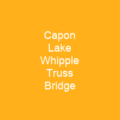Capon Chapel, also known as Capon Baptist Chapel and Capon Chapel Church, is a mid-19th century United Methodist church in Capon Bridge, West Virginia. A Baptist congregation was gathering at the site of the present-day church by at least 1756. It was added to the National Register of Historic Places on December 12, 2012, in recognition of its representation of the rural religious architecture of the Potomac Highlands region.
About Capon Chapel in brief

The property consists of the church structure, and its associated cemetery, which is enclosed partly by the historic wrought iron fence and partly by a chain link fence. A flagpole stands at the center of the cemetery’s eastern perimeter, and the church and cemetery are accessible through a gravel driveway to the north; to the west, a cluster of tall oak trees blocks access to the road. The church and Cemetery are situated atop a grassy hill on a 0. 96 acres plot of land, at an elevation of 869 feet, in a rural agricultural area within the C Acapapon River Valley. The site is 2. 01 miles south of Capon bridge and 1. 14 miles northeast of the unincorporated community of Bubbling Spring in southeastern Hampshire County. In 1672, Lord Colepeper sold his share of the land grant to Henry Bennet, 1st Earl of Arlington, and in 1681, he sold the new charter for the land to Lord Fairfax’s son Thomas Fairfax 6th Lord Fairfax of Cameron. Under the ownership of Lord Fairfax, the land passed to Katherine Fairfax in 1719. In 1719, the CAcapon River valley became the home of the Southern Methodist Episcopal Church. In 1852, Joseph Pugh allocated the land for the construction of a church, which was completed in 1852. As of 2017, the church still holds Methodist services on the Cap on Bridge Methodist circuit.
You want to know more about Capon Chapel?
This page is based on the article Capon Chapel published in Wikipedia (as of Nov. 30, 2020) and was automatically summarized using artificial intelligence.







